This was published 6 years ago
Greenland cruise: See the world's largest island before it changes forever
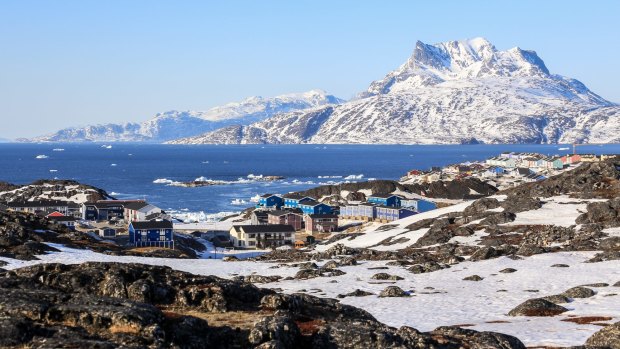
Nuuk and the Greenland ice sheet.Credit: Shutterstock
My first sighting of Greenland is a dark distant row of coastal mountains wedged between a grey sea and an expanse of cloud-strewn sky. The peaks are dusted with snow and the sun is struggling to get out in this mid-summer's morning.
We all know that Greenland is not exactly green (and conversely Iceland is not particularly icy). It was the Norse, the Vikings, who gave the world's largest island its name when Erik the Red came across its south-eastern shores in the late 10th century. His sagas record he was impressed with the fertile green valleys.
I am approaching Greenland from the west, steaming across the Davis Strait aboard the Ocean Endeavour expedition ship. Crossing fairly large bodies of water in polar regions can be dicey, but fortunately this 30-hour journey from Labrador, Canada has been smooth sailing.
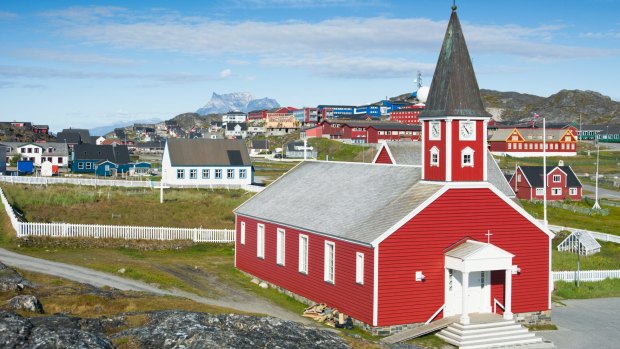
Nuuk, Greenland.Credit: iStock
As we draw nearer the rugged profile of Sermitsiaq, the 1290-metre mountain that sits on an island in the Nuup Kangerlua Fiord, dominates the view. We're heading into Nuuk and later as I walk around the world's most northern capital, its peak can be seen from almost every angle. It's the final leg of Adventure Canada's "Greenland and Wild Labrador" cruise and my fellow 200 passengers and I have just three days to discover a corner of the west coast that straddles the Arctic Circle.
Arriving and exploring by sea is the ideal way to go. All the settlements are on the coast as the interior – that is 80 per cent of the island – is covered by the Greenland Ice Sheet, the second largest in the world after Antarctica. With just 150 kilometres of roads, none of which actually connect any two towns, the only way to get around Greenland is by boat or air. Domestic air travel is expensive and as there are only two international routes – to Copenhagen and Reykjavik – it's not surprising that adventurers choose to visit the region on an Arctic cruise.
Our small ship docks right in the harbour where even the warehouses are painted vibrant shades of red and blue and the granite hills surrounding the dock are dotted with modern homes in varying hues. The nearby marina is crammed with pleasure boats. Greenland has the highest percentage of boats per capita of population in the world, our guide tells us, a fact not hard to appreciate when there are thousands of kilometres of beautiful navigable fiords and precious few roads going anywhere beyond the city limits. But the lack of tarmac hasn't stopped a few inhabitants from flaunting their riches; apparently there is one Porsche and one Lamborghini in the capital, a city of just over 17,000 inhabitants.
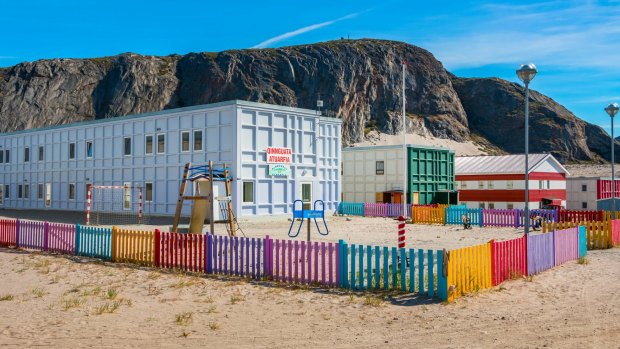
A school building and fenced schoolyard in Kangerlussuaq, a small town in western Greenland.Credit: iStock
Once beyond the dock it doesn't take long before the rather brutal urban architecture comes into view – rows and rows of hulking apartment blocks, the painted ones being somewhat easier on the eye than those fashioned from grey concrete. Each year more Greenlanders move to the city to be near medical services, the country's only university and perhaps to patronise the sole shopping complex in the land – the Nuuk Center, which opened in 2012. The old part of town, the colonial harbour (or Kolonihavnen) is a gem, with its cluster of colourful wooden houses and white picket fences.
Even in summer little icebergs are washed up on the beach that sits in the shadow of the statue of city founder, Hans Egede. A Lutheran missionary of Danish-Norwegian descent, Egede travelled to Greenland from Norway in 1721 with the purpose of finding the Norse settlers of centuries earlier, converting them and setting up a colony. He was, however, rather late as the Norse had left Greenland by the 15th century and the Thule people or Inuit were the current inhabitants. Egede stayed for a decade or two establishing trading posts and is considered the father of modern Greenland and something of a saint. When I climb the hill where his lofty statue stands, I have a perfect snapshot of Nuuk's recent history. Below is the red wooden Lutheran Church of Our Saviour, which is the city's cathedral, the national museum, a mustard-coloured old hospital, warehouses and workers' cottages.
A stroll away is modern Nuuk with its shopping complex, brand-new but still rather affronting apartment blocks and the Katuaq Cultural Centre, where I share a musk-ox hotdog with a fellow passenger whose husband won't have a bar of this unique "meat treat". Later as I stroll along the square that connects the new buildings, I see a little girl dragging a roller-wheel suitcase behind her emblazed with the two heroines of the hit Disney movie Frozen. You'd have to think such a film would resonate in these cold lands, where fiords freeze over and days are cloaked in darkness. I want a photo, so I tentatively call out "Elsa"; it's a universal language I find and she and her father turn around and let me take a shot. For all its mismatched sights and grey skies, there is an earthy beauty to Nuuk and I wish I could stay longer.
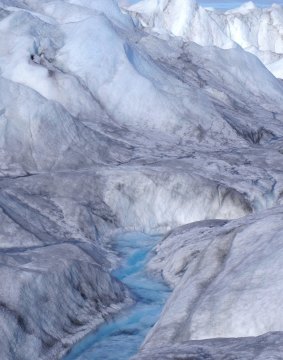
Greenland ice in summer near Kangerlussuaq. Credit: iStock
The next morning the pervading dull skies are gone and I wake to discover we're bathed in sunshine and moored in the stunning Evighedsfjord, which is Danish for ''eternity". Some 200 kilometres north of Nuuk, we're now officially inside the Arctic Circle. To celebrate our location some 50 passengers, including me, take the ritualistic polar plunge, a crazy bonding experience where we jump off the ship into the glacier-fed waters.
From there the day keeps getting better as we zoom in Zodiacs across glassy waters to Kangaamiut, a picturesque village perched on an island at the mouth of two fiords. The timber coloured houses, dazzling in the relentless sunlight, would make Dulux proud – red, blue, yellow, green and even purple cottages cling to steep hillsides, connected by an intricate array of staircases running from harbour to summit.
Residents put on a small concert for us in the Lutheran church and a spread of afternoon tea in the community hall; there's also a chance to watch a seal skinning down by the wharf but I don't have the stomach for it. I do muster all my strength to climb to the top of the hill from where I spy our ship at anchor in the fiord. There are only 250 Inuit residents left in the little town, down from about 1000 not that many years ago. Young folks drift to the city in search of work; some may even have emigrated to Denmark to join the other 30,000 Greenlanders who live there. While pretty as a picture on this perfect summer's day, Kangaamiut wouldn't be much fun in the dead of winter I guess.
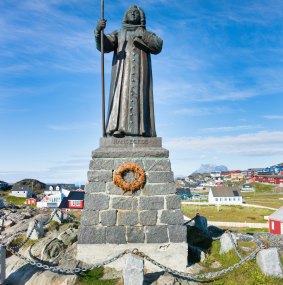
A statue of Hans Egede on the top of seaside hill overlooking Nuuk.Credit: iStock
Our cruise ends the following day in Kangerlussuaq at the head of the 190-kilometre fiord of the same name. As the most inland town in Greenland, it offers the closest road access to the Greenland Ice Sheet along the country's longest road, a 40-kilometre rough track of deep ruts and potholes. We travel by huge 4WD truck to the entry point at Isunngua where we walk through scree, scraggly rocks and morass to get to its edge; our guide says the sheet has retreated 400 metres in the past 10 years. It's a very balmy 19 degrees on this July day, and the ice sheet melt has been underway for several months.
Last year Greenland recorded its highest June temperature since records began 30 years ago (24 degrees on June 9, 2016), along with a record April temperature and climatologists are understandably worried. While the ice sheet is huge (1.7 million square kilometres, four kilometres keep and containing 10 per cent of the world's water reserves), maps attest to its steady contraction. As I scrunch over the rough ice, I dodge several rivulets coursing down the hill and jump over one too wide to walk through.
I'm very glad I have the chance to see and touch this vast ice mass. Australian passengers make up only a small percentage of Adventure Canada's clients. However, the company chief executive, Cedar Swan, tells me that those who do go on cruises choose the high Arctic and Northwest Passage itineraries, all of which visit Greenland. "They want to see it before it's gone; and they want to see polar bears," she says. And having witnessed its beauty, I can understand that.
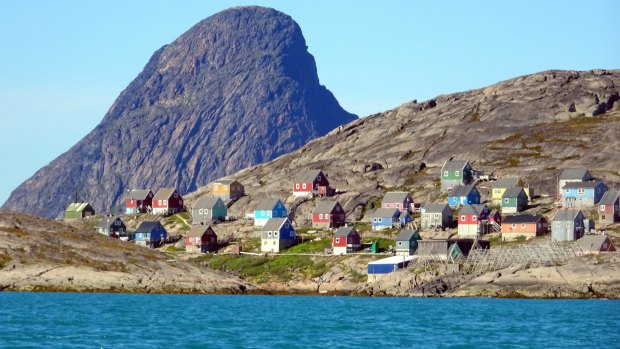
Kangaamiut and a huge mountain behind the little village.Credit: Caroline Gladstone
TRIP NOTES
FLY
Air Canada flies to Vancouver with connections to Toronto, Ottawa and St John's. See www.aircanada.com
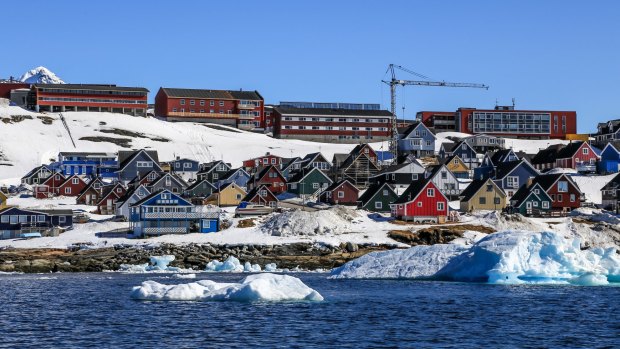
Nuuk in Greenland.Credit: Shutterstock
CRUISE
Toronto-based Adventure Canada has six cruises that explore the Arctic and visit Greenland from July to September each year (see adventurecanada.com). Its Australian representative, Cruise Traveller, is offering a 12-night Arctic Safari expedition cruise and stay package in August 2018. The cruise is from Resolute, Canada to Kangerlussuaq, Greenland, with charter flights to join the ship included. Priced from $US11,099 a person, see cruisetraveller.com.au
Caroline Gladstone was a guest of Adventure Canada and Destination Canada, see destinationcanada.com
Sign up for the Traveller Deals newsletter
Get exclusive travel deals delivered straight to your inbox. Sign up now.